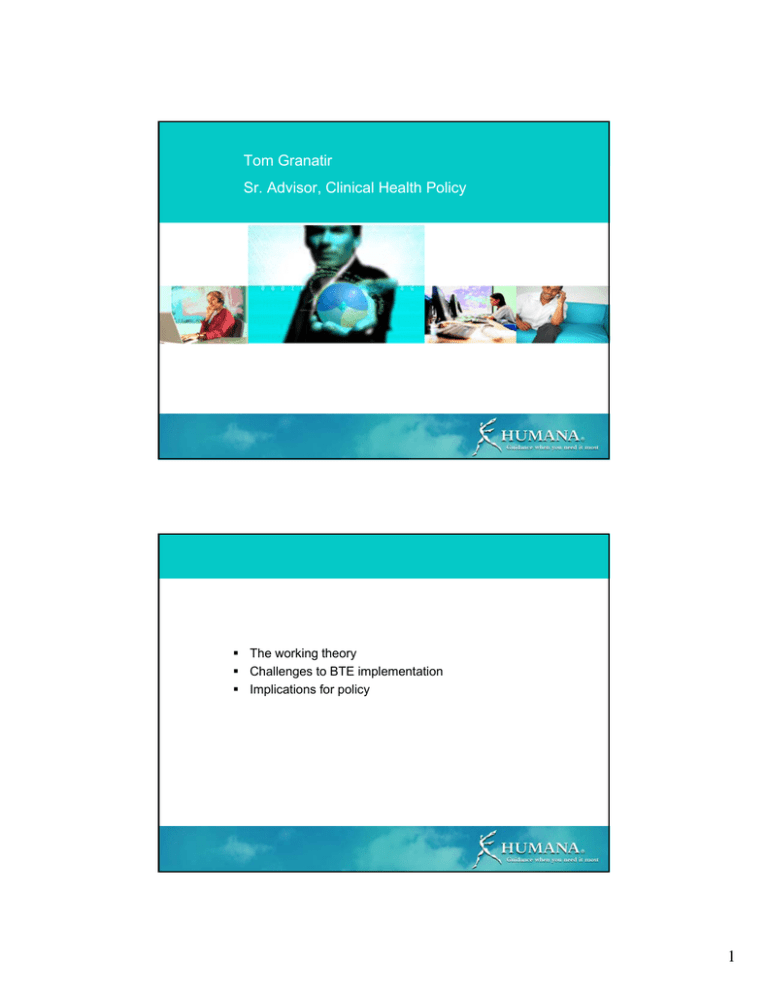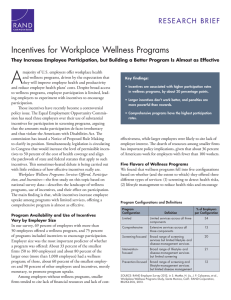1 Tom Granatir Sr. Advisor, Clinical Health Policy The working theory
advertisement

Tom Granatir Sr. Advisor, Clinical Health Policy The working theory Challenges to BTE implementation Implications for policy 1 Crossing the Quality Chasm IOM Vision – interpreted EMPLOYERS CARE SYSTEM Organizations that facilitate the work of patientcentered teams Supportive market environment High performing patient-centered teams OUTCOMES • • • • • • Safe Effective Efficient Personalized Timely Equitable GOVT & PLANS CARE SYSTEM RE-ENGINEERING IMPERATIVES Redesigned care processes Effective use of information technologies Knowledge and skills management Development of effective teams Coordination of care across patient conditions, services, and settings over time • Use of performance and outcome measurement for continuous quality improvement and accountability • • • • • 1Adapted from Crossing the Quality Chasm by A. Milstein, 2003. 2 IOM Vision – reinterpreted EMPLOYERS CARE SYSTEM Organizations that facilitate the work of patientcentered teams Supportive market environment High performing patient-centered teams OUTCOMES • • • • • • Safe Effective Efficient Personalized Timely Equitable GOVT & PLANS CARE SYSTEM RE-ENGINEERING IMPERATIVES Redesigned care processes Effective use of information technologies Knowledge and skills management Development of effective teams Coordination of care across patient conditions, services, and settings over time • Use of performance and outcome measurement for continuous quality improvement and accountability • • • • • 1Adapted from Crossing the Quality Chasm by A. Milstein, 2003. New Belief System - A dysfunctional market No market incentives to improve care and reduce waste – We pay more for poor quality in rework to compensate for quality defects (readmissions, additional diagnostic or physician care) – Focus on payment for individual services creates no incentives to organize better systems of care Known quality problems representing 25 – 40% waste – overuse (needless care that could be harmful) – under-use (effective care that is not delivered) – mis-use (poorly delivered care) Consumers lack information to guide choices – Consumers have to seek information about individual providers rather than care organized around their medical problems The only way to find sustainable savings will be by reorganizing care – Payment strategies that not only reward excellence but encourage the creation of more organized systems of care 3 The working theory – LFG and BTE Leapfrog and Bridges to Excellence grow out of the same frustration by employers They want their contracted health insurers to leverage relationships with members and networks – information to members – incentives for members to choose “best” – rewards for hospitals and physicians that adopt safe and effective practices – network designs that make differences in performance visible to consumers Employers will create incentives for employees to choose the plans that most actively manage their networks Bridges to Excellence Two very different models – Certification of process excellence – Office practice reengineering - creating more “system” in office practice Incentives for patients – to take more control over their care – to change their health behavior 4 Measuring Physicians & Hospitals Efficiency Physicians Hospitals Effectiveness HPN Self Reported = NCQA, BTE Claims Reported = AHM, RAND Patient Reported = CFP, ACAHPS * ALOS Total Cost/Admit Self Reported = LFG Claims Reported = Hospital Value Index Patient Reported = HCAHPS* Hospital Value Index HCUP = Health Care Cost and Utilization Project, tracks in-patient & hospital safety Challenges Employer recruitment – Tyranny of the “plan year” – Attitudes toward benefits – The free rider – Market makers v. market takers Physician recruitment – Returns to physicians – Maturity of physician practices − Ability to respond to incentives – Mixed incentives − Administrative burden v. reward − Disincentives for public recognition Patient Incentives 5 Challenges Provider-specific metrics worthy of consumer choice – Quality measures that are scientific & understood by consumer – Attributable to -- somebody – Reimbursements bundled in ways that are meaningful to patients (e.g., episodes of care) and manageable by providers – Cost measures that clarify the cost consequences of their choices Plans – Contracting conflicts – Market penetration – Payment system flexibility – Member retention – Poisoned relationships and lack of trust Government – on the sidelines? Lessons from The Medicare CABG Demonstration Global payment to hospital included pre- and post-hospital care $50.3 million in savings to Medicare over 5 years Implementation of evidence-based clinical protocols Innovations in ICU management & nursing deployment (personal nursing model) led to reductions of 10 - 40 percent in ICU costs 30% reduction in pharmacy cost per case Significant reductions in inpatient mortality despite increases in case severity Improved beneficiary satisfaction 6 Implications New expectations for the delivery system – Measurement – Information systems – Organized systems of care – New payment approaches - Global payments for episodes of care Policy implications – Measurement – Market-moving demonstrations – Revitalize global payment demonstrations – Evaluation support 7




